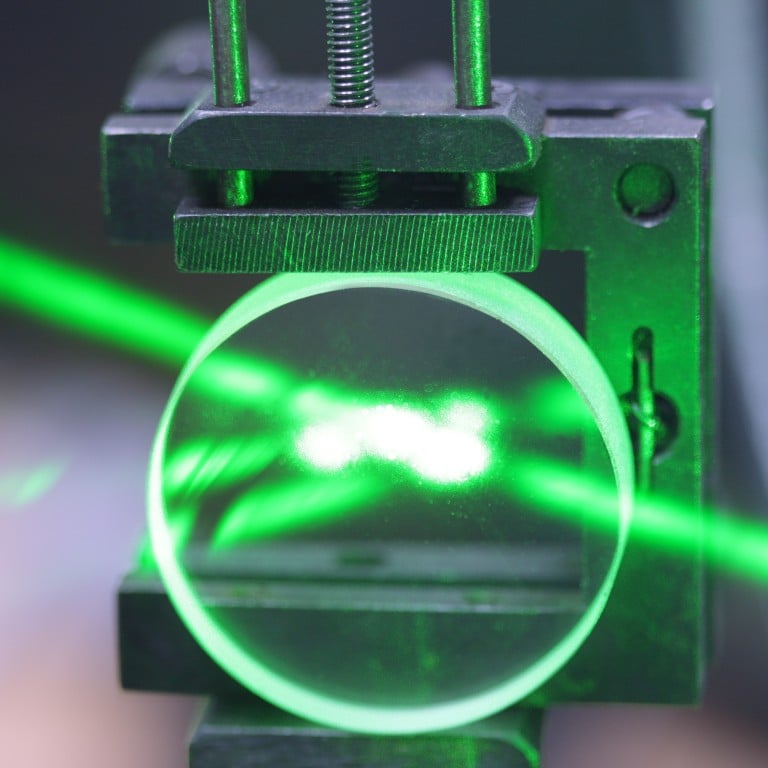
Could this 1-dollar Chinese adhesive defeat a billion-dollar US laser weapon?
- Chinese researchers say their industrial resin mixture has enough heat resistance to protect ballistic missiles from laser attacks
- ‘BPR-1’ and other advances in protective technology are pushing the arms race in directed energy weapons to a new stage, scientist says
Scientists in China who have been experimenting with materials to protect drones and missiles from laser attacks say they have discovered a surprising potential solution – adhesive.
An experiment showed that a common low-cost resin showed promise in protecting such weapons from being damaged by laser weapons, according to the scientists.
Samples coated with the material remained intact after being blasted by a weapons-grade laser beam for 15 seconds with a power density of 500 watts per sq cm – far more intense that what is required to destroy an unprotected ballistic missile.
The newest, most powerful laser currently available to the US military generates a 300-kilowatt beam. Megawatt-power laser systems do not yet exist but are under development.
In their experiment, the researchers applied 2.5mm (0.1 inch) of coating that was mostly made of boron phenolic resin (BPR), a composite material widely used in hot and high-stress environments.
China is the world’s largest manufacturer of BPR, where one factory can produce hundreds of thousands of tonnes of BPR annually.
BPR is also inexpensive. In recent years, the average price of the resin has dropped to as low as 7 yuan (US$1) per kg (2.2 pounds), according to industrial data in China.
“This solution uses low-cost raw materials, a simple manufacturing process and has very high performance,” said Gao and her colleagues in a peer-reviewed paper published in the Chinese-language journal Ordnance Material Science and Engineering on May 17.
Russia claimed to have destroyed numerous US Patriot missile defence launchers with its Kinzkal hypersonic missiles. The Pentagon had confirmed some damage.
Iran unveils Conqueror ‘hypersonic missile’, amid tensions with US
Admiral Michael Gilday, the chief of US naval operations, said developments in hypersonic weapons by America’s adversaries had made laser weapons a “top priority” for the US military.
“From a defensive standpoint, we’re focused on the threat,” he was quoted as saying by CNN during a public event in August.
The US Department of Defence reportedly spends US$1 billion a year on laser weapon development.
US House panel reviewing university with Pentagon contract for ties to China
Laser weapons are seen as a promising countermeasure because a focused laser beam travels at the speed of light.
BPR is already used on many missiles and high-speed drones as a heat protection layer, according to Gao’s team.
But a laser energy beam – focused and intense enough – could burn a hole through a traditional BPR coating in just a few seconds, the team said.
So, Gao’s team bought some inorganic compounds “straight from the market”, such as silicon carbide, zirconium dioxide and carbon black nanopowder, and added them to the original resin. The result was a new composite tested under the codename “BPR-1”.
“Over time, white material appeared in the ablated area of BPR-1, but the heat impact area remained relatively intact with no obvious peeling or damage to the coating,” the researchers said in the paper.
After being subjected to a laser for 15 seconds, the BPR-1 coating showed a maximum back surface temperature of 230 degrees Celsius (445 Fahrenheit) – not hot enough to damage most aerospace aluminium alloys, which have a minimum melting point of 400 degrees Celsius.

Laboratory analysis of the blast area showed that many spherical particles had appeared and fused together at the bottom of the ablation pit.
The researchers also found molten glasslike materials across the heat-affected zone.
The particles and glasses were likely created by the added compounds, which formed a protective buffer that filled in the gaps in the resin to prevent further damage, the researchers said.
BPR-1 and other recent advancements in protective technology are pushing the directed energy weapons arms race between the United States and China to a new stage, according to a Beijing-based laser scientist.
“Welcome to Star Wars 2.0,” said the researcher, who requested not to be named due to the sensitivity of the technology.
The condensed power source can be used to generate a laser or high-powered microwave, weapons that could target not only missiles and aircraft, but also satellites in lower-Earth orbit.



